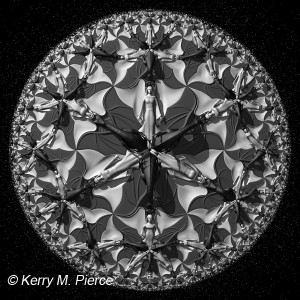 We have looked at four of Dr. John Medina’s Brain Rules.
We have looked at four of Dr. John Medina’s Brain Rules.
Vision. Vision is our dominant sense. “We learn and remember best through the use of pictures, not through written or spoken words.”
Attention. As I heard Spielberg state: “You’ve got to hook them in the first ten minutes.” In other words, we don’t pay attention to boring stuff.
Repetition. “Repeat to remember.”
And finally, Medina’s twelfth brain rule: “We are powerful and natural explorers.” Curiosity itself is perhaps the most important brain rule. M. C. Escher was the poster child for these Brain Rules. Escher is the Dutch artist who did all the work with tessellations or what others refer to as tiling or regular division of the plane. The image shown is my 3D interpretation of Escher’s Circle Limit IV.
Escher used vision by creating visual artwork to express what was on his mind. He writes: “All I am doing in my prints is to offer a report of my discoveries.”
Attention. In a letter to his brother Escher wrote: “Perhaps all I pursue is astonishment and so I try to awaken astonishment in my viewers.” Early on when I first saw an Escher print, I was hooked. His visual images got my attention.
Curiosity. Beyond just getting my attention, Escher’s prints made me want to explore. I wanted to understand what he did and how he did it. He awoke in me a deep desire to study his art to a deeper level.
Finally, repetition. Escher was the master of repetition without allowing the viewer to become bored. He created order out of chaos and it is beautiful.
Escher had unique attributes. First, he was ever curious, ever on to the next print, ever addicted to the thrill of intellectual discovery. Near the end of his life he stated: “I could fill an entire second life with working on my prints.” Second, Escher was ever changing. As an artist he morphed and transformed over time. He didn’t discover a style and stop. He started with landscapes and moved on to tessellations. He did metamorphoses prints and moved onto investigations of perspective. Towards the end of his life, approaches to infinity appear in his artwork. Third, Escher was driven. He simply worked hard on the problems he was trying to solve. Relentlessly. You find this aspect of his character covered in the books written about him. I didn’t fully appreciate how demanding his work was until I tried to duplicate it and occasionally try to extend it.
Escher lived the brain rules. It is not surprising then that we find the brain rules in his artistic statements.
As Christians we can learn from Escher. But what about the Spiritual side of M. C. Escher? He created at least 20 pieces of biblical artwork. We investigate the Spiritual side of M. C. Escher in part 2.
